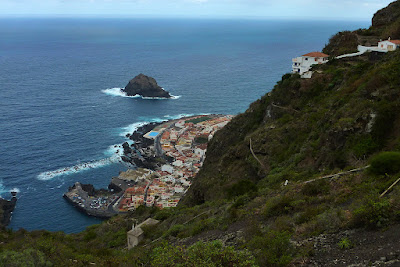 |
| Starting from Puerto Cruz at sea level. |
My first impression of the island, looking through the window of a bus leading me to my base at Puerto de la Cruz, was not encouraging. I was looking at the labyrinth of highways with huge amount of traffic. I had the impression I'd arrived in the middle of Shanghai or Detroit.
Next morning I calmed my frustrations by taking triple servings from a buffet breakfast. In the time of distress, food always provides a great source of consolation. After the breakfast I went to the cycle shop to get the bike that I'd reserved for the next 6 days. It was an aluminium road bike with compact double 105 group and - as I noted few days later - 25 teeth cassette, which was rather high gearing for the steep gradients on the island. The uninspiring white-red design didn't result in love on the first sight, but that was OK - it wouldn't be a good steal material either. Right from the bat I started with the big climb to El Teide. It's one of the world greatest climbs: 45 km from the sea level up to 2350 m altitude at the base of the 3718 m high volcano, the climb that practically never levels out. I don't think there is a bigger climb in Europe.
 |
| Volcano El Teide. |
 |
| At the base of El Teide (2350 m) |
The traffic that looked so daunting last night was actually quite benign. The traffic volume was high up to the last village at Aguamansa, but the drivers were more then considerate. They would wait behind you indefinitely, following you at 8 km/h as you struggled up the 12 % grade, without slightest hint of nervousness - they were embarrassingly polite. On the way up I stopped a few times, but no worries, I had 5 more days to honey the climbing technique to perfection. On the way down I was a bit cautious, I haven't had experience with these kind of tires and I had the feeling that the bike was floating when cornering. There was also some fog on the way down. The cloud layer follows a peculiar formation on the island. When there are clouds, they tend to occupy the middle portion of the altitude - from about 1000 m to 1600 m. Under and above that it's sunshine and about 20 degrees C, but when you enter the clouds it drops down to under 10. The cold made me stop a few times on the way down, which was a pity as it would otherwise be a once-in-a-lifetime 45 km non-stop descent.
 |
| Sinking back into the clouds at 1600 m. |
Day 1: 101 km, +2535 m.

























